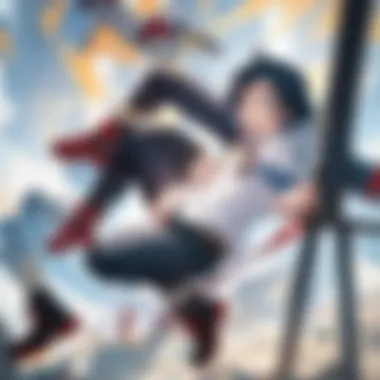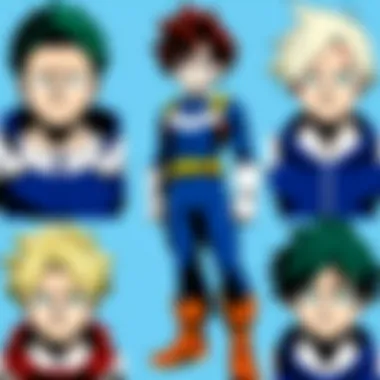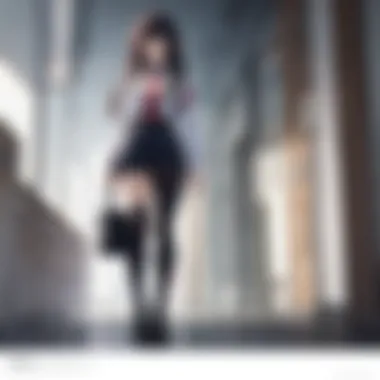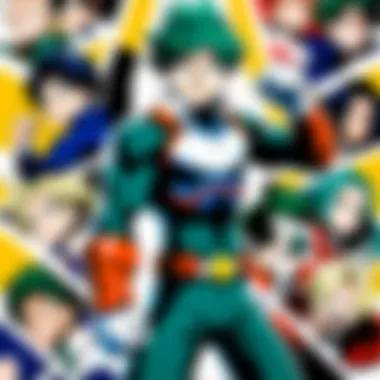A Comprehensive Look at My Hero Academia Series


Intro
The world of anime and manga has gone through dynamic changes over the decades, but certain series stand out, shaping the landscape and influencing future creations. One such series is My Hero Academia, which has taken the anime and manga scenes by storm since its debut. The rich storytelling, compelling character arcs, and vibrant art have not only captivated audiences but have also sparked numerous discussions about its deeper meanings and cultural significance.
As we embark on this exploration, it’s worth considering what makes this series resonate with both newcomers and entrenched fans. The universality of its themes—heroism, ambition, and personal growth—combined with a meticulously crafted narrative, offers a well-rounded view of society’s complexities. This article sets out to provide a thorough examination of My Hero Academia, assessing its various elements and the profound impact it has had on modern pop culture.
In the sections that follow, we will delve into specific aspects of the series, starting with episode reviews that highlight the significance of key moments, discuss character development, and finally, compare the anime with its manga counterpart. Through these analyses, we will uncover not just the allure of the story, but also explore the various interpretations and anticipations fans hold in discussing this intricate universe.
Preamble to My Hero Academia
When it comes to contemporary anime, few titles stand shoulder to shoulder with My Hero Academia. This series has not only captured the hearts of fans globally but has also forged a significant mark in the landscape of anime and manga. The series, created by Kohei Horikoshi, holds a mirror to societal expectations, heroism, and personal growth, making it not just an engaging tale of superheroes but also a profound commentary on real-world issues. The following sections will dissect these elements meticulously, providing both new viewers and seasoned fans with a panoramic understanding of the series.
Overview of the Series
My Hero Academia is set in a world where almost everyone possesses superpowers known as "Quirks." The protagonist, Izuku Midoriya, known as Deku, is one of the few individuals born without a Quirk. However, his aspirations to become a hero lead him on a remarkable journey. The narrative unfolds through various arcs—ranging from the students' struggles at U.A. High School, to perilous confrontations with villains, and themes that often reflect personal and collective dilemmas. Its blend of action-packed sequences and emotional depth elevates it within the genre, allowing viewers to connect with characters on a personal level.
Historical Context in Anime and Manga
To appreciate My Hero Academia, one must glance back at the historical context in which it was born. The series debuted in 2014, amidst a burgeoning interest in superhero narratives, coinciding with the global popularity of Western superhero franchises. However, it brings a unique twist to the genre; instead of merely emulating Western styles, it incorporates traditional Japanese storytelling methods and elements.
The impact of prior works like Naruto or One Piece is undeniable, as they paved the way for My Hero Academia to explore themes of friendship, rivalry, and perseverance. Moreover, the rise of shonen manga established a framework within which the series could thrive, resonating with a generation that found itself enthralled by tales of heroes striving to make their mark in a complicated world. This context is essential for understanding why the series has resonated with audiences and how it continues to influence modern anime trends.
"With great power comes great responsibility" – a theme cemented in My Hero Academia, urging its audience to reflect on their societal role, aligning with the nods to both Eastern and Western narratives.
Narrative Structure
The narrative structure of My Hero Academia serves as the backbone of the entire series. It shapes how the story unfolds, makes sense of character motivations, and influences viewer engagement at various levels. Understanding this structure not only enhances appreciation for the series but also provides insights into its storytelling techniques that keep the audience on the edge of their seats. This article will delve into three critical aspects of the narrative: plot development across seasons, character arcs and evolution, and the pacing and storytelling techniques utilized.
Plot Development Across Seasons
Each season of My Hero Academia is meticulously crafted to build upon previous events, shaping a rich tapestry of narrative depth. For example, the first season introduces us to Izuku Midoriya, a boy born without superpowers in a world where they are the norm. As the plot thickens, the stakes escalate, sending Midoriya on a journey filled with trials and tribulations. The carefully planned plot twists maintain a tension that draws viewers in, making them eager to see how the characters will resolve conflicts.
Furthermore, the transitions between arcs, such as the U.A. Sports Festival and the National License Exam, keep the momentum alive while allowing for character growth and world-building. The season-ending cliffhangers, often a hallmark in anime, serve to heighten anticipation, ensuring that fans remain invested in the unfolding story. This artful development of the plot creates a captivating cycle of expectations and surprises, inviting the audience to journey alongside the characters.
Character Arcs and Evolution
Character arcs in My Hero Academia are not just a means to an end; they are essential to the narrative's richness and emotional depth. For instance, take the character of Katsuki Bakugo. His evolution from a bully overshadowing Midoriya into a complex figure grappling with insecurities and expectations illustrates the series’ commitment to nuanced storytelling. As viewers, we witness not just the highs and lows of their hero journey but how they evolve through challenges and interactions with others.
The supporting cast also receives significant attention, with characters like Ochaco Uraraka and Shoto Todoroki experiencing profound transformations. This development is purposeful, as it reflects real-life growth and struggles. Essentially, character arcs are woven tightly into the plot, resulting in a narrative that feels coherent and engaging. By experiencing growth alongside them, the audience forms emotional connections, making the inevitable struggles and victories that much more impactful.


Pacing and Storytelling Techniques
Pacing is crucial in My Hero Academia, masterfully balancing moments of intense action with quieter, introspective scenes. Fast-paced action sequences, such as battles against villains, are interspersed with character-driven moments where emotions surface and relationships deepen. The series employs various storytelling techniques to maintain this balance, such as flashbacks that clarify a character's motivations or shifting perspectives that illuminate different sides of the conflict.
The use of humor and light-hearted interactions also adds layers to the pacing. Characters engage in banter, offering brief respite from action-heavy sequences, highlighting the importance of camaraderie in a hero's journey. As a result, the storytelling remains fluid and engrossing, allowing viewers to digest the intensity of the action while remaining engaged in the characters' emotional journeys.
"Narrative structure is not just about events; it’s about the cadence of those events, forming a rhythm that resonates with the audience."
Character Analysis
Character analysis in My Hero Academia is essential for multiple reasons. First, it delves into intricate personalities and growth, unfolding various narratives that shape not just the individual characters but the overall story. This series does not just spotlight heroes but also emphasizes the significance of supporting and villain roles, making each character's journey a piece in a larger puzzle.
Through detailed character arcs and the emotional depths they portray, viewers connect to them, forging emotional ties that are vital for a compelling narrative. Not only does this provide entertainment, it also stirs some profound reflections on societal roles, morality, and personal growth.
Izuku Midoriya: The Protagonist's Journey
Izuku Midoriya, often colloquially referred to as "Deku," is the heart of the series. Starting as an ordinary boy in a world brimming with extraordinary abilities, his narrative arc is a growing testament to perseverance. His journey from being quirkless to mastering All Might's power reveals the quintessence of determination and friendship.
Midoriya’s evolution is not just about acquiring strength; it's about developing an indomitable spirit. His trials, errors, and victories resonate with viewers, showcasing the often messy path to becoming a hero. Each challenge pushes Deku to evolve, signaling growth that is both emotional and physical. The delicate balance between his eagerness to protect others and his struggle with self-doubt makes him relatable. This multifaceted character embodies the very essence of what it means to be both a hero and a human.
Supporting Cast and Their Roles
The strength of My Hero Academia also lies in its extensive supporting cast. Characters like Katsuki Bakugo, Ochaco Uraraka, and Shoto Todoroki each bring unique dynamics to the table. They serve not merely as backdrops in Midoriya’s journey but also steer the narrative in pivotal ways.
- Katsuki Bakugo: Often antagonistic, his complex rivalry with Midoriya underscores a theme of rivalry and respect. Their relationship evolves, each challenging the other while showcasing their growth as characters.
- Ochaco Uraraka: She personifies the essence of kindness amidst chaos, offering a softer side that contrasts with the often intense struggles in the series.
- Shoto Todoroki: His layered background adds texture to the storyline, as he grapples with familial expectations and societal pressures.
This dynamic interplay not only enriches the primary narrative but also accentuates various themes, such as friendship, determination, and identity.
Villainous Characters and Their Motivations
No great hero story is complete without formidable foes. The villains in My Hero Academia are particularly nuanced, posing significant threats while also embodying complex motivations that evoke sympathy rather than simple hatred. Characters like Tomura Shigaraki and Stain showcase how personal conviction can drive destructive paths.
- Tomura Shigaraki: His journey echoes the impacts of trauma and loss, making him a tragic villain. The depth of his character prompts a reflection on the consequences of societal neglect.
- Stain: Arguably the moral compass of some villainous archetypes, he stands for a twisted interpretation of heroism, questioning what it means to be a true hero.
Each villain thus contributes layers to the storyline, prompting viewers to consider moral ambiguities and the gray areas between right and wrong.
"Villains are not born; they are shaped by the world around them. Understanding their motivations reveals not only their depths but also the failures of society."
Themes and Motifs
The world of My Hero Academia is stitched together by various themes and motifs that resonate deeply with both its characters and the audience. These underlying principles give the narrative not just a framework but also a rich texture, making the series relatable and thought-provoking. Elements such as heroism, the dynamics of friendship and rivalry, and the struggle between societal expectations and individual identity weave a tapestry that invites deeper analysis. Each theme not only enriches character arcs but also challenges the audience to reflect on their own lives and choices.


By delving into these ideas, we can grasp the narrative depth that sets this series apart from other anime.
Heroism and Moral Dilemmas
At the crux of My Hero Academia lies the complex nature of heroism. The protagonist, Izuku Midoriya, embodies a classic hero's journey - or does he? The series raises essential questions about what it means to be a hero. Is heroism defined solely by power, or does it encompass moral choices and responsibilities? Characters often grapple with moral dilemmas that push them to the brink. For instance, All Might, the symbol of peace, faces the weight of his legacy as he confronts his limitations.
The essence of heroism is layered, revealed through choices that often blur the lines between right and wrong.
"A hero is someone who saves not just with power, but with heart."
Through such narrative moments, viewers are encouraged to consider their own definitions of heroism.
Friendship and Rivalry
The bonds of friendship and the sting of rivalry create a dynamic that drives character interactions throughout My Hero Academia. The friendships depicted in the series often manifest through mutual support, showcasing how characters like Katsuki Bakugo and Izuku Midoriya transition from fierce rivals to allies. Their turbulent relationship serves as a significant lens through which the series explores the intricate dance between camaraderie and competition.
Such relationships do not merely serve as background noise; they propel character growth and emotional stakes. When the stakes are high, friendships illuminate the moments of vulnerability that define human connection. In contrast, rivalries push characters to exceed their limits, challenging them to become their best versions.
Societal Expectations and Individual Identity
In a world where quirks define social status, My Hero Academia boldly delves into societal expectations and the quest for individual identity. The character arc of Shoto Todoroki exemplifies this struggle, caught between the burden of his family's expectations and the desire to forge his own path. The theme invites viewers to reflect on their authentic selves in the face of external pressures.
This resonates deeply within today’s culture, where individuals often wrestle with conforming to established norms versus seeking their own truths. The series tackles these nuances head-on, ultimately portraying the importance of embracing one's uniqueness, a theme that deeply resonates with the audience.
The examination of these motifs not only enriches the viewing experience but also encourages introspection, leading fans to revisit their own values and aspirations. This exploration has solidified the narrative as a cornerstone in contemporary anime, inviting discussions that broaden the understanding of heroism, relationships, and identity.
Artistic Style and Animation
In the realm of anime, artistic style and animation play a crucial role in shaping the viewer's experience. For My Hero Academia, it is not merely a backdrop to the narrative; it is a vibrant force that breathes life into characters and their adventures. The colors, designs, and movements all convey emotions and themes that resonate with the audience, becoming a powerful conduit for storytelling.
Character Design and Aesthetics
My Hero Academia stands out for its diverse character design, which reflects not just their quirks but also their personalities and backgrounds. From Izuku Midoriya's earnest, slightly awkward appearance to Katsuki Bakugo's explosive, fiery look, the designs resonate deeply with their respective stories. Each character has a unique visual identity that helps viewers immediately understand their role in the narrative.
- Complexities of Quirk Representation: The quirks often dictate aesthetic choices. For instance, Shoto Todoroki’s half-cold, half-hot appearance vividly symbolizes his duality, enhancing the narrative depth.
- Evolution in Character Design: As characters grow and evolve, their design may reflect that journey. For instance, Midoriya's gradual transformation from a timid boy to a confident hero is mirrored in subtle changes to his outfit and posture, making viewers more invested in his growth.
"The design of a character goes beyond looks; it encapsulates their psyche, their struggles, and their journey in a way that mere dialogue sometimes cannot convey."
The aesthetic choices in My Hero Academia often include vibrant colors and intricate details that draw viewers into a world filled with imagination and creativity. This careful attention makes it easy for fans to connect on an emotional level, deepening their understanding of each character's journey.


Action Sequences and Visual Storytelling
The action in My Hero Academia is nothing short of exhilarating. Each sequence is crafted to capture not just the physical skill of the characters but also their emotional stakes within those moments. The choreography reflects the impact of their quirks—energy blasts, fiery explosions, or even gravitational shifts—and these become pivotal in communicating drama rather than just being flashy.
- Dynamic Animation Techniques: Animators expertly use various techniques, such as frame-by-frame animation, to create that sense of motion. When Deku unleashes a powerful smash, the fluidity and intensity of the frames pull viewers into the heart of the battle, making them feel the weight of each strike.
- Symbolism through Action: Many action sequences carry significant symbolism. When characters face their demons, the way they engage in battle often mirrors their internal struggles. This layer of visual storytelling creates a richer narrative experience for the audience.
Cultural Impact
In the landscape of contemporary anime and manga, My Hero Academia stands out not only for its riveting story and character development but also for its significant cultural impact. This section meticulously explores how the series resonates with its audience, influences popular culture, and shapes future trends in the industry.
Reception and Critique
From its debut, My Hero Academia was met with an enthusiastic reception that transformed it into a staple in anime discourse. Its introduction of relatable characters grappling with personal and external challenges struck a chord with viewers of all ages. Critical acclaim flowed from multiple fronts, including fans and critics who praised its depth and diversity in character representation.
Many reviews highlight the show's ability to tackle pressing themes like heroism and identity without descending into mere caricatures. For example, The Animation Resource noted, "My Hero Academia presents a thoughtful critique of traditional hero narratives while maintaining an engaging storyline."
However, not all reception has been glowing. Some critiques point to uneven pacing in certain arcs and disparities in character focus across episodes. The shift between light-hearted moments and intense battles sometimes leaves viewers feeling a bit disjointed. Fan discussions on platforms like Reddit often dive into these critiques, fostering engaging dialogues that enhance the overall viewing experience.
"The show may falter at times, but the emotional weight carried by the characters ultimately redeems it," a common sentiment echoed in various critiques.
Influence on Modern Anime Trends
The influence of My Hero Academia on newer series is hard to deny. It has inspired a wave of anime that emphasize character-driven narratives layered with intricate world-building. For instance, shows like Jujutsu Kaisen and Demon Slayer echo the blend of action, character growth, and thematic depth seen in My Hero Academia.
Here are a few elements that showcase its influence:
- Character Development: Newer series now prioritize multidimensional characters facing moral dilemmas, a hallmark of My Hero Academia.
- Diverse Representation: The growing presence of a multi-ethnic cast in anime today reflects the precedent set by My Hero Academia, broadening horizons beyond the traditional paradigms.
- Genre Blending: The successful mixture of various genres, including sports, action, and comedy within a single narrative framework, has become a common approach in many new titles.
Overall, the threads that My Hero Academia has woven into the fabric of anime culture are unmistakably profound, encouraging creators to push the envelope while appealing to a diverse audience.
Epilogue
The final chapter of any extensive analysis offers a chance to reflect on the journey undertaken. In the case of My Hero Academia, this discussion brings to light the enormous impact this series has had on both the anime and manga landscape. It’s not merely a story of heroes and villains; it's a reflection on the essence of heroism, the weight of expectations, and the sometimes convoluted path towards self-identity.
Reflection on the Series' Legacy
The legacy of My Hero Academia is profound, and it extends far beyond its captivating plot and well-rounded characters. The series has tapped into various societal issues, particularly the juxtaposition of individual aspirations against the backdrop of community and societal norms. Fans resonate with Izuku Midoriya's struggles not just because he aims to become a hero, but also because his journey illustrates the need for perseverance in the face of overwhelming odds. No longer just a tale of saving the day, it has forged a space in popular culture that invites discussions around mental health, morality, and duty.
Moreover, its influence is palpable in a plethora of new titles gracing the industry today. What sets My Hero Academia apart is its ability to shape narratives that are as character-driven as they are action-packed. From creator Kohei Horikoshi's distinctive art style to the storytelling techniques employed, the series leaves an indelible mark - inspiring all who witness its evolution. Herein lies the beauty of its legacy, one that will likely lead aspiring creators to explore similar themes in their own works.
Future Directions for the Franchise
As we look towards the horizon, several paths seem ripe for exploration within the My Hero Academia universe. With the manga continuing to unfold, there's potential not only for new arcs but also for deep dives into previously uncharted territories of the story.
- Expanding the World-Building: The introduction of new characters, both heroes and villains, opens avenues for complexity. New societies or schools dedicated to hero training could add layers to the already intricate world.
- Diving Deeper into Villain Psychology: While the series has done a commendable job of fleshing out its primary antagonists, an in-depth look at their motivations and backstories could provide additional nuance. Understanding the reasons behind their actions creates a richer narrative landscape.
- Potential Crossovers: Considering current trends in the anime world, crossovers with other popular series could attract a broader audience, linking different fanbases through shared storylines or characters.
All these elements suggest that the franchise holds significant untapped potential and remains a cornerstone of contemporary anime for years to come. As we conclude, it's clear that My Hero Academia is not just a series but a powerful commentary on heroism and humanity.







